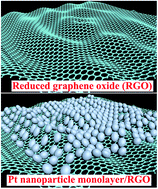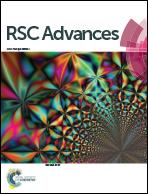Monolayer of close-packed Pt nanocrystals on a reduced graphene oxide (RGO) nanosheet and its enhanced catalytic performance towards methanol electrooxidation†
Abstract
Owing to the high hydrophobicity of the graphene surface and the easy aggregation of Pt nanoparticles, it is very challenging to deposit high loading and a uniform distribution of Pt nanoparticles on graphene nanosheets. Herein, we report a facile approach to produce nanocomposites of Pt nanoparticles and reduced graphene oxide (Pt/RGO) with the intervention of glucose. The number density and arrangement of Pt nanoparticles on RGO nanosheets can be adjusted simply by changing the amount of Pt precursors. With the increase of the amount of Pt precursors, the loading amount of Pt nanoparticles rises and simultaneous Pt nanoparticle arrangement evolves from sparse distribution to a close-packed monolayer, to linear aggregation. HRTEM reveals that Pt nanoparticles are (111)-orientated nanocrystals (NCs) close to 3 nm. Pt24/RGO (Pt, 24 wt%) holds an excellent catalytic performance and stability towards methanol oxidation, ∼3 times in the mass activity better than the commercial Pt/C catalyst (Pt, 20 wt%), due to the close-packed monolayer structure of Pt NCs.


 Please wait while we load your content...
Please wait while we load your content...